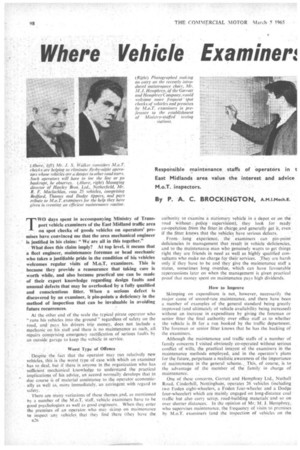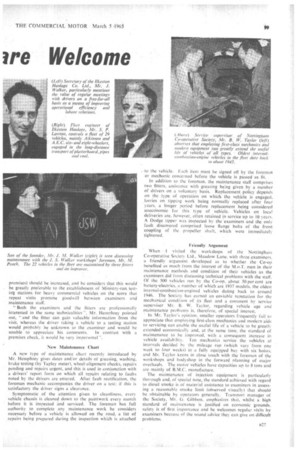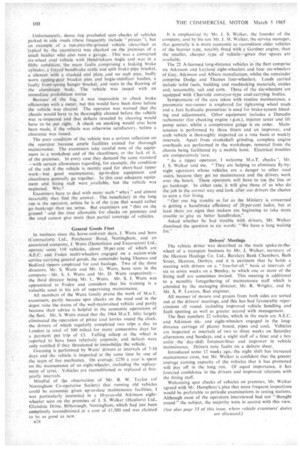Vehicle Examinen ire Welcome
Page 100

Page 101

Page 102

If you've noticed an error in this article please click here to report it so we can fix it.
Responsible maintenance staffs of operators in t East Midlands area value the interest and advice M.o.T. inspectors.
By P. A. C. BROCKINGTON, Two days spent in accompanying Ministry of Transport vehicle examiners of the East Midland traffic area on spot checks of goods vehicles on operators' premises have convinced me that the area mechanical engineer is justified in his claim: "We are all in this together."
What does this claim imply? At top level, it means that a fleet engineer, maintenance foreman or head mechanic who takes a justifiable pride in the condition of his vehicles welcomes regular visits of M.o.T. examiners. This is because they provide a reassurance that taking care is worth while, and also because practical use can be made of their expert knowledge regarding design faults and unusual defects that may be overlooked by a fully qualified and conscientious fitter. When a serious defect is discovered by an examiner, it pin-points a deficiency in the method of inspection that can be invaluable in avoiding
future recurrences.
At the other end of the scale the typical pirate operator who "runs his vehicles into the ground" regardless of safety on the road, and pa} s his drivers trip money. does not include a mechanic on his staff and there is no maintenance as such, all repairs comprising emergency rectification of serious faults by an outside garage to keep the vehicle in service.
Worst Type of Offence
Despite the fact that the operator may run relatively new vehicles. thii is the Worst type of case With which an examiner has to deal, but if there is anyone in the organization who has • sufficient mechanical knowledge to understand the practical implications of his advice, an accord normally develops that in (hie course is of material asssistanee to.the operator economically as well as, more immediately, an astringent with regard to safety.
There are many variations of these themes and, as mentioned by a number of the M.o.T. 'staff, vehicle examiners have to be good psychologists as well as good engineers.. When they enter the premises of an operator who may skimp on maintenance to inspect any vehicles that they find there (they have the
n26
authority to examine a stationary vehicle in a depot or on the road without,: police supervision), they look for ready co-operation fibril the litter in charge and generally get it, even if the fitter knOws that the vehicles have serious defects.
From long experience; the examiners can pin-point deficiencies In management that result in vehicle deficiencies, and to the maintenance man who genuinely wants to get things right they are friends in need as well as highly qualified consultants who make no charge for their services. They are harsh only if they have to be and they give the maintenance staff a status. sometimes long overdue, which can have favourable repercussions later on when the management is given practical proof that money spent on maintenance pays high dividends.
How to Improve
Skimping on expenditure is not, however, necessarily the major cause of second-rate maintenance, and there have been a number of examples of the general standard being greatly improved (and ultimately of vehicle availability being increased) without an increase in expenditure by giving the foreman or senior fitter the final authority over office staff as to whether the vehicle is fit for a run booked by the traffic department. The foreman or senior fitter knows that he has the backing of the examiners.
Although the maintenance and traffic staffs of a number of family concerns I visited obviously co-operated without serious conflict of wills, the practical interest of the examiners in the maintenance methods employed, and in the operator's plans for the future, perpetuate a realistic awareness of the importance of maintenance in the general scheme.. ,This, of course, is to the advantage of the member of the family in charge of maintenance. .
One of these concerns, Garratt and Hemphrey Ltd„ Nuthall Road: Cinderhill, Nottingham. operates 26 vehicles (including two Foden eight-wheelers, a Foden four-wheeler and a Dodge four-wheeeler) which are mainly engaged on long-distance coal traffic but also carry scrap. road-building materials' and-so tin over shorter distances. In the opinion of Mr: M. J. Hernphrey, who supervises maintenance, the frequency of visits to premises by M.o.T. examiners (and the inspection of vehicles on the
premises) should be increased, and he considers that this would be greatly preferable to the establishment of Ministry-run. testin u stations for heavy commercial vehicles on the score that repeat visits promote goodwill between examiners and maintenance staff.
" Both the examiners and the fitters are professionally interested in the same technicalities ". Mr. Hemphrey pointed out, " and the fitter can gain valuable information from the visit, whereas the driver taking a vehicle to a testing station would probably be unknown to the examiner and would he unable to appreciate his comments. In contrast with a premises check, it would be very impersonal New Maintenance Chart A new type of maintenance chart recently introduced by Mr. Hemphrey gives dates and/or details of greasing, washing, brake testing (by Tapley meter), wheel-alignment checks, repairs pending and repairs urgent, and this is used in conjunction with a drivers' report form on which all repairs relating to faults noted by the drivers are entered. After fault rectification, the foreman mechanic accompanies the driver on a test; if this is satisfactory the driver signs a clearance..
Symptomatic of the attention given to cleanliness, every vehicle chassisis cleaned down to the paintwork every month before it is inspected and serviced. The foreman. has full authority to complete any maintenance work he considers necessary before a vehicle is allowed on the road, a list of repairs being prepared during the inspection whieh is attached
to the vehicle. Each item must be signed off by the foreman or mechanic concerned before the vehicle is passed as fit.
In addition to the foreman, the maintenance staff comprises two fitters, assistance with greasing being given by a number of drivers on a voluntary basis. Replacement policy depends on the type or operation on which the vehicle is engaged, lorries on tipping work being normally replaced after four years, a longer period before replacement being considered uneconomic for this type of vehicle. Vehicles on local deliveries are. however, often retained in service up to 10 years, A Dodge tipper was inspected by the 'examiners and the only fault discovered comprised loose flange bolts of the front coupling of the propeller shaft, which were immediately tightened.
Friendly Argument
When I visited the workshops of the Nottingham Co-operative Society Ltd., Meadow •Lane, with three-examiners, a friendly argument developed as to whether the Co-op benefited as much from the interest of the M..o.T. men in their maintenance methods and condition of their vehicles as the examiners did from discussing technical problems with the staff. Of the 500 vehicles run by the Co-op, about 50per cent are battery-electries, a number of which are 1937 models, the oldest internal-combustion-engined vehicles dating back to around 1946. The Society has earned an enviable reputation for the mechanical Condition of its fleet and a comment by -service superviser Mr. B. W. Taylor, regarding vehicle age and maintenance problems is, therefore, of special interest, In Mr. Taylor's opinion, smaller operators frequently fail, to appreciate that employing first-class mechanics and modern aids to servicing can enable the useful life of a vehicle to be greatly extended economically and, at the same time. the standard of maintenance to he improved, with a consequent increase in vehicle availability. Ten mechanics service the vehicles at intervals decided hy the mileage run (which vary from one week to four weeks) in a fully equipped bay with six hoists, and Mr. Taylor keeps in close touch with the foreman of the workshops and bodyshop in the forward planning of major -overhauls. The motor vehicles have capacities up to 8 tons and are mainly of B.M.C. manufacture.
The maintenance of injection equipment is particularly thorough and, of special note, the standard achieved with regard to diesel smoke is of material assistance to examiners in assessing a reasonable smoke limit (observed visually) that should be obtainable by operators generally. Transport manager or the Society, Mr. G. Gibbon. emphasizes that, whilst a high standard of maintenance is justified • on economic grounds, safety is of first importance and he welcomes regular visits by examiners because of the sound advice they can. give on difficult problems.
. Unfortunately, dense fog precluded spot •checks of vehicles parked in side roads (these frequently indiide" pirates "), but an example of a run-,into-the-groundvehicle (described as typical by the examiners) was checked on the 'Premises of a small haulier who also runs a garage. , This was a converted six-wheel . coal vehicle with Hendrickson bogie and , was in a filthy condition; the main faults . comprising. a leaking brake cylinder, a frayed handbrake cable and split firake-pipe bracket, a silencer with a cracked end plate.and no stub pipe, badly worn tipping-gear bracket pins and bogie-stabilizer bitshes, a faulty front-spring hanger bracket, and rents in the flooring of the aluminium body. The vehicle was issued • with an
immediate prohibition notice , Because of the fog, it was 'impossible to check brake efficiencies with.“ meter. but this would have been done before the vehicle was cleared. The operator was warned that the chassis would have to be thoroughly cleaned before the vehicle was re-inspected, and that defects revealed by cleaning would have to be put right. A cheek on smoking would also have been made, if the vehicle was otherwise satisfactory, befbre a clearance was issued,
. The poor condition of the vehicle was a serious reflection on the operator because ample facilities existed for thorough Maintenance. The examiners take careful note of the equipment in a workshop and of the cleanliness, or the lack of it, Of the premises. In every case they demand the same standard =with certain allowances regarding, for example, the condition of the cab if the vehicle is mainly used for short-haul tipper work--but good maintenance, pp-to-date equipment and cleanliness generally go together. In this case adequate equipment and fitting staff were available, but the vehicle was
neglected. Why? .• ,
Examiners. have to deal with many such " why s" and almost invariably they tind the answer. The beneficiary in the long run is the operator, Unless he is of the type that would rather gobankrupt than see sense. But examiners are "thin on the ground ''-andthe time allowable fors cheeks on premises and the road cannot give mote than partial coverage of vehicles.
General Goods Fleet In business since the. horse-and-Cart days, J. Watts and Sons (ContraciorS) Ltd., PorcheSter Road, Nottingham, and an associated company, I. Watts (Demolition and Excavation) Ltd., operate some 110' vehicles, about 50 per cent of Which are A.E.C. and Foden multi-Wheelers engaged On a nation-wide service carrying general goods, the remainder being Thames and Bedford tippers employed for coal haulage. Two of the three directors, Mr. S. Watts and Mr. G. Watts, have sons in the company—Mr. S. J. Watts and Mr. D. Watts respectively— the third director being. Mr. L. Watts. Mr. S. J. Watts was apprenticed to Foden and considers that his training is a valuable asset in his job of supervising maintenance.
All members of the Watts family praise the work of M.o.T. examiners, partly because spot checks on the road and in the depot raise the status of the well-maintained vehicle and partly because their advice is helpful in the economic operations of the fleet. Mr. S. Watts stated that the 1964 M.o.T. blitz largely .eliminated the operation of pirate coal lorries round the clock, the drivers of which regularly completed two trips a day to ,London (a total of. 500 miles), for many consecutive days for a payment per trip of .i3. Falling asleep at the wheel is reported to have been relatively .commin, and.-defeets were only rectified if they threatened to immobilize the vehicle. •
Greasing is performed by Watts' drivers at intervals of 7-10 days and the vehicle is inspected 'at the same time by one of the team of five mechanics. On average; £250 a. year is spent on the maintenance of an eight-wheeler, excluding the replacement of tyrei. Vehicles are reckditioned or replaced at tiVeyearly intervals.
. Mindful of the observation of Mr. B. W. Taylor (of Nottingham Co-operative Society) that running old vehicles could be economic given up-to-date" maintenance facilities, I was particularly interested in, a 10-year-old Atkinson eightwheeler seen on the .premises of J. S. Walker (Hauliers) Ltd., Glaisdalc Drive, Bilborough, Nottingham,. which had just been completely reconditiOned.ata cost of £1,590 and was claimed to he as good as new.
u28
It is emphasized by Mr. J. S. Walker, the founder of the company, and by his son Mr. J. M. Walker, the service manager, that generally it is more economic to recondition older vehicles of the heavier ly ete, notably fitted with a Gardner engine, than the smaller, cheaper .type of vehicle—given thar-spares arc available.
The 22 A-licensed long-distance vehicles in the fleet comprise six Atkinson and Leyland eight-wheeler i and four six-wheelers of Guy, Atkinson and Albion manufacture, whilst the remainder comprise Dodge and Thames four-wheelers. Loads carried include 'solid fuels, building and roadmaking materials, oxides and, seasonably, salt and corn. Three of the six-wheelers are' equipped with Charrold conveyor-type coal-carrying bodies.
Symptomatic of the care taken with routine maintenance, a pneumatic nut-runner is employed for tightening wheel studs and a Jam hydraulic pressurizer is used for brake-system bleeding and adjustments. Other equipment includes a Dunedin tachometer (for checking engine r.p.m.), injector tester and lift pump tester, whilst a compression gauge is on order. Maintenance is performed by three fitters and an improver, and each vehicle is thoroughly inspected on a rota basis at weekly intervals. Apart from crankshaft grinding, complete engine overhauls are performed in the workshops, removal from the chassis being facilitated by a mobile hoist. Electrical troubles are comparatively 'rare.
" As a tipper operator, I welcome M.o.T. Checks'', Mr. J. S. Walker told me. "They are helping to eliminate fly-bynight operators whose vehicles are a danger to other road users, because they get no maintenance and the drivers work over the hours. These operators will have to toe the line or go bankrupt. In either case, it will give those of Os who do the job in the correct way and look after our drivers the chance to earn a fair living.
"Our one big trouble as far as the Ministry is concerned . is getting a handbrake efficiency of 20 per cent laden, but at least there are signs that makers are beginning to take more trouble to give us better handbrakes."
Asked whether he had trouble with drivers, Mr. Walker dismissed the question in six words: "We have a long waiting list."
Drivers' Meetings The vehicle driver was described as the main spoke,in-thewheel of a transport business by Mr. J. Walker, secretary of the Ilkeston Haulage Co. Ltd., Barclays Bank Chambers. Bath Street, Ilkeston, Derbys, and it is pertinent that he holds a meeting with drivers on a " free-for-all" basis at intervals of six to seven weeks on a Sunday, to which one or more of the fitting staff are sometimes invited. This meeting is additional to a monthly foregathering of maintenance staff which is attended by the managing director, Mr. R. Wrigley, and by Mr. S. P. Lawton, fleet engineer.
All manner'of moans and groans from both sides are sorted out at the drivers' meetings, and this has had favourable repercussions all round, including improved vehicle handling and fault spotting as well as greater accord with management.
The fleet numbers 22 vehicles, which in the main are A.E.C. and Atkinson sixand eight-wheelers engaged in the longdistance carriage of plaster board, pipes and coal., Vehicles are inspected at intervals of two to three weeks on Saturday afternoons and Sundays, and a night staff of a fitter and a boy asSist.,.the day-shift foreman-fitter and improver in vehicle maintenance. Drivers note faults on a defects Sheet.
Introduced some 12 weeks ago,the night shift has increased maintenance cOsts, but Mr. Walker is. confident that the greater average earning capacity of the Vehicles that it has promoted will pay off in the long: run. Of equal importance, it has fostered confidence in the drivers and improved relations with the fitting staff. Welcoming spot checks of vehicles on premises, Mr. Walker agreed with Mr. Hemphrey's plea that more frequent inspections would be preferable to periodic examinations in testing stations. Although most of the operators interviewed had not "thought round" the subject, the majority were in accord with this view.




























































































































































